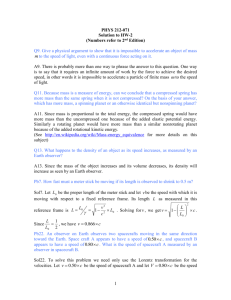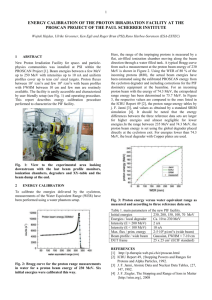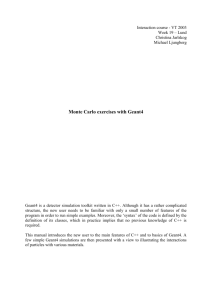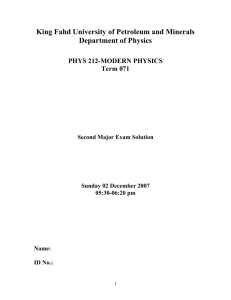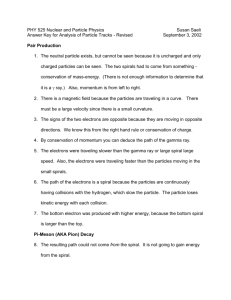PROBset2_2015_eight question_so_some_spare
advertisement
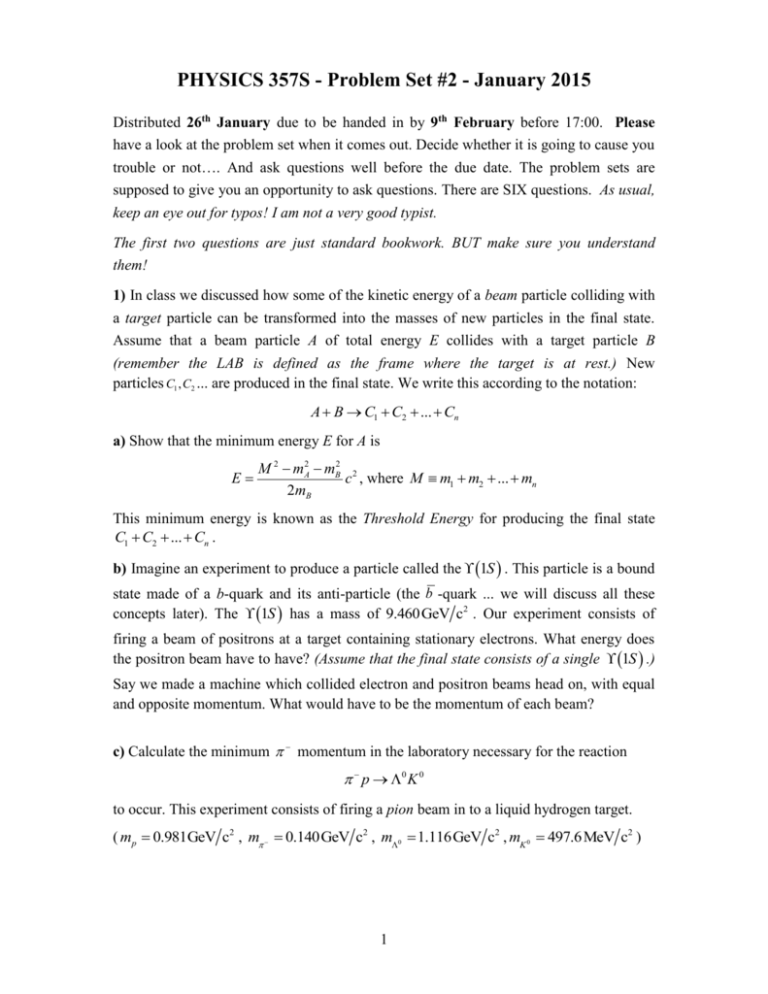
PHYSICS 357S - Problem Set #2 - January 2015
Distributed 26th January due to be handed in by 9th February before 17:00. Please
have a look at the problem set when it comes out. Decide whether it is going to cause you
trouble or not…. And ask questions well before the due date. The problem sets are
supposed to give you an opportunity to ask questions. There are SIX questions. As usual,
keep an eye out for typos! I am not a very good typist.
The first two questions are just standard bookwork. BUT make sure you understand
them!
1) In class we discussed how some of the kinetic energy of a beam particle colliding with
a target particle can be transformed into the masses of new particles in the final state.
Assume that a beam particle A of total energy E collides with a target particle B
(remember the LAB is defined as the frame where the target is at rest.) New
particles C1 , C2 ... are produced in the final state. We write this according to the notation:
A B C1 C2 ... Cn
a) Show that the minimum energy E for A is
E
M 2 mA2 mB2 2
c , where M m1 m2 ... mn
2mB
This minimum energy is known as the Threshold Energy for producing the final state
C1 C2 ... Cn .
b) Imagine an experiment to produce a particle called the 1S . This particle is a bound
state made of a b-quark and its anti-particle (the b -quark ... we will discuss all these
concepts later). The 1S has a mass of 9.460GeV c2 . Our experiment consists of
firing a beam of positrons at a target containing stationary electrons. What energy does
the positron beam have to have? (Assume that the final state consists of a single 1S .)
Say we made a machine which collided electron and positron beams head on, with equal
and opposite momentum. What would have to be the momentum of each beam?
c) Calculate the minimum momentum in the laboratory necessary for the reaction
p 0 K 0
to occur. This experiment consists of firing a pion beam in to a liquid hydrogen target.
( mp 0.981GeV c2 , m 0.140GeV c2 , m0 1.116GeV c2 , mK 0 497.6MeV c2 )
1
2) The new particles produced in these experiments are often unstable, and rapidly decay.
Consider a particle A at rest (i.e. consider the particle in its rest-frame, or CM {centre-ofmass, or centre-of-momentum} frame) decaying according to the scheme:
A BC
Show that the energy of B is:
EB
mA2 mB2 mC2 2
c
2mA
and also show that the outgoing momenta are given by
pb pc
mA2 , mB2 , mC2
2m A
c
where
x, y, z x2 y 2 z 2 2xy 2xz 2 yz
Use these results to find the energy in the CM frame of each decay product in the
following reactions.
a) W
b) 0
c) B0
d) 0
c) K
The W has a mass of 80.425GeV c 2
The photon is the quantum of light, and is massless.
The is massless (well…. You can assume it is massless, it has a tiny mass.)
The B particle is a bound state of a b-quark and a d-quark. It has a mass of
5279 MeV c 2
The particle is in some way like a heavy neutral proton. One of the u-quarks in the
proton is substituted by an s-quark. It only appears with no electric charge, so the
superscript is omitted. The mass is 1116 MeV c 2 . The is distinguished from the
proton by carrying one unit of a quantum number called strangeness; due to the s-quark.
The has two s-quarks and an u-quark; its mass is 1314.8 MeV c 2 . The consists of
three s-quarks and so carries three units of this strangeness quantum number. It has a
mass of 1672 MeV c 2 .
2
3) (a) Consider the process, in the LAB
K p K 0 p .
The final state K has a momentum of 5GeV c and the 0 has a momentum of
4GeV c , and the angle between them is 7.3 . Calculate the invariant mass of the K 0 .
These momenta and the angle are measured with finite experimental errors, so the
invariant mass maybe of order 1% away from the “true” invariant mass. Now go to
http://pdg8.lbl.gov/rpp2014v1/pdgLive/ParticleGroup.action;jsessionid=3564179CD97F
D90E46E69FD74C51584B?node=MXXX020
and check if there is a particle that might have a rest mass corresponding to the invariant
mass of this combination.
(Take the mass of a K to be 493.677 MeV c 2 , The mass of the to be 139.57 MeV/c2.)
(b) OK. Say there IS such a particle on that web page, what interaction do you think
causes the decay of this particle? Base your answer on the mean lifetime of the particle.
You can calculate that from the total width given on the web page.
(c) Assume that the K 0 comes from an intermediate state, and that the beam
momentum in this experiment is 20GeV c . Calculate the momentum of the final state
proton in the CM frame.
(d) Say you take many events of this type. Sketch the invariant mass distribution of the
K 0 combination for the cases where the intermediate state particle exists, and where it
does not. In the former case, indicate the scale of the x-axis in units of MeV c 2
4) The 0 meson is like an excited 0 . It has all the same quark content as the pion; but
the quarks are in a state with one unit on angular momentum… hence the mass is larger
than the pion, viz. 769 MeV c 2 . It can be produced by colliding a pion beam with a
liquid hydrogen target, in the reaction,
p 0n .
It decays in about 10 24 s to and , and the decay width is 154 MeV c 2 .
(a) What is the lifetime and mean decay distance of a 5 GeV c 0 ?
(b) What is the threshold energy for producing 0 in the reaction above?
(c) Assume in the above reaction that the 0 is produced in the forward direction in the
LAB frame. What is the minimum and maximum opening angle of the two pions from
thee rho decay in the LAB frame?
5) A dominant pion decay process is
3
Assume that a traveling at a speed v decays this way. If the emerges at 90
to the original pion direction, show that the comes off at an angle of
tan 1 m2 m2 2 2
This problem is described in the LAB frame. m and m are the rest masses of the pion
and muon, while the neutrino is massless. ( Neutrinos are not massless actually. They
have tiny masses, as discovered at Sudbury (Ontario) Solar Neutrino Observatory.
6) In our discussion of colliding beam machines, I discussed colliding particles of equal
masses and equal and opposite momenta head on. The Large Hadron Collider at CERN
will be such a machine; a proton synchrotron. It will accelerate counter rotating beams of
protons to an energy of 7 TeV per beam.
a) If the bending magnets in the LHC have an field of 8.7 T, what is the radius of the
machine? Assume that the machine is circular, and that the tunnel is full of bending
magnets.
b) Why is the machine designed to have a CM energy much greater than the supposed
mass of the Higgs? All I want is an explanation in words. (hint: the Higgs is not
produced alone, and it is not at rest)
c) The (now canceled) Superconducting SuperCollider was designed to be similar to the
LHC; but with an energy of 20 TeV per beam. Imagine that you wanted to reach the same
centre of mass energy by constructing a giant accelerator to reach the same centre of
mass energy as the SSC, but with a stationary proton target. What would be the diameter
of this machine if the bending magnets were limited to a field of 6 T?
d) Assume that we want to produce the same CM energy by colliding protons from an
accelerator with stationary electrons in a liquid hydrogen target. What would have to be
the beam energy of such a machine?
7) There is a large cyclotron on the campus of UBC; the TRIUMF cyclotron. This
machine is a sector focused cyclotron. The magnetic field is arranged to change with
radius, so that acceleration occurs at a constant RF frequency. The particles are injected
from a small linac into the centre of the cyclotron. Even tho’ it’s old, TRIUMF is still the
highest energy cyclotron in the world, and is the injector for the TRIUMF radioactive
beam facility. TRIUMF was designed by Reg Richardson, a student of Lawrence. Some
parameters of the cyclotron are.
Injection energy: 300 keV
4
Final Energy: 520 MeV
Maximum Radius: 310 inches (built in 1970, before Canada adopted metric system)
Injection Radius: 12 inches
Particles accelerated: H ions.
1) Why does the magnetic field have to change radially?
2) Calculate the B field at injection and maximum energy.
3) What is the RF frequency of the accelerating voltage?
4) If this machine had been built as a synchrocyclotron, calculate the change in the RF
frequency from injection to maximum energy.
8) The largest linear accelerator in the world was the SLAC (Stanford Linear Accelerator
Center) electron LINAC. The accelerator produced electrons of 40GeV c momentum.
However, plans are afoot to build a linear collider with momentum in each beam of
500 GeV c . The machine will collide electrons with positrons.
a) What is the mass of the most massive new particle one could produce with this
machine? What would the momentum of this particle be in the LAB frame?
b) If we use these electrons from one beam to probe for structures inside the proton, what
structure size could we resolve? How does that compare with the present limits on the
size of a quark? Calculate the resolving power of the SLAC electron beam
c) Calculate the velocity of the electrons as they exit from the accelerator.
d) If the electrons experience a constant accelerating force eE and are accelerated over 15
km, find the effective accelerating field E. I mean the strength of the electric field in
Volts/metre in the direction of the particles, which accelerates them.
e) How far would the electrons have to travel in this field in order to reach the same
velocity if Newtonian mechanics applied?
f) Estimate the length of the one “arm” of this accelerator as seen in the electron rest
frame. Assume that the electrons are always travelling at approximately the velocity of
light
5
Possibly Useful Physical Constants:
6 1023 mole 1
3.1416
c 3.0 108 m s
Avogadro No:
pi
speed of light:
6.6 1022 MeV s
c 197 MeV . fm
Plank's constant:
c
2
0.4 GeV 2 mb
1 eV 1.6 1019 Joules
1 eV c 2 1.8 1036 kg
1 fm 1015 m
1 mb 1027 cm 2
1 year
1 year 107 s
electron charge:
electron magnetic moment:
e 1.602 1019 C
e 9.31024 Joules Tesla1
6
strong coupling constant:
c 1 137.0360
s M Z 0.116 0.005
Fermi coupling constant:
Cabibbo angle:
GF 1.166 105 GeV 2
sin C 0.22
Weak mixing angle:
sin 2 W M Z 0.2319 0.0005
e2
fine structure constant:
BR Z e e 3.21 0.07%
Branching Ratios
BR Z hadrons 71 1%
________________________________________________________________________
Particle Properties
Boson
Mass GeV c 2
Lepton
W
3 1036
~0
80.22
Z0
91.187
e
e
H0
~ 125
gluon
Hadron
, ,
0
Quark Content
ud , uu dd
2 , du
Mass MeV c 2
139.57,134.97, 139.57
Mass MeV c 2
105
0.510999
0.27
105.658
10
1777
1 0
I J PC
K, K
us , su
493.65
1
0
2
K 0, K 0
ds , sd
497.67
1
0
2
7
, 0,
ud , uu dd
2 , ud
775.7
1 1
p ,n
uud , udd
938.27, 939.57
1 1
2 2
, 0 , ,
ddd , udd , uud , uuu
1232
3 3
2 2
0
uds
1115.6
1
0
2
D0 , D0
uc , cu
1863
1
0
2
D , D
dc , cd
1869
1
0
2
DS , DS
cs , cs
1968
B , B
ub , ub
5279
c
udc
2285
1
0
2
1
0
2
, 0 ,
uus, uds, dds
1189
1
0 ,
uss, dss
1315
1 1
2 2
sss
1672
3
0
2
b
udb
5624
1
0
2
8
0 0
1
2
